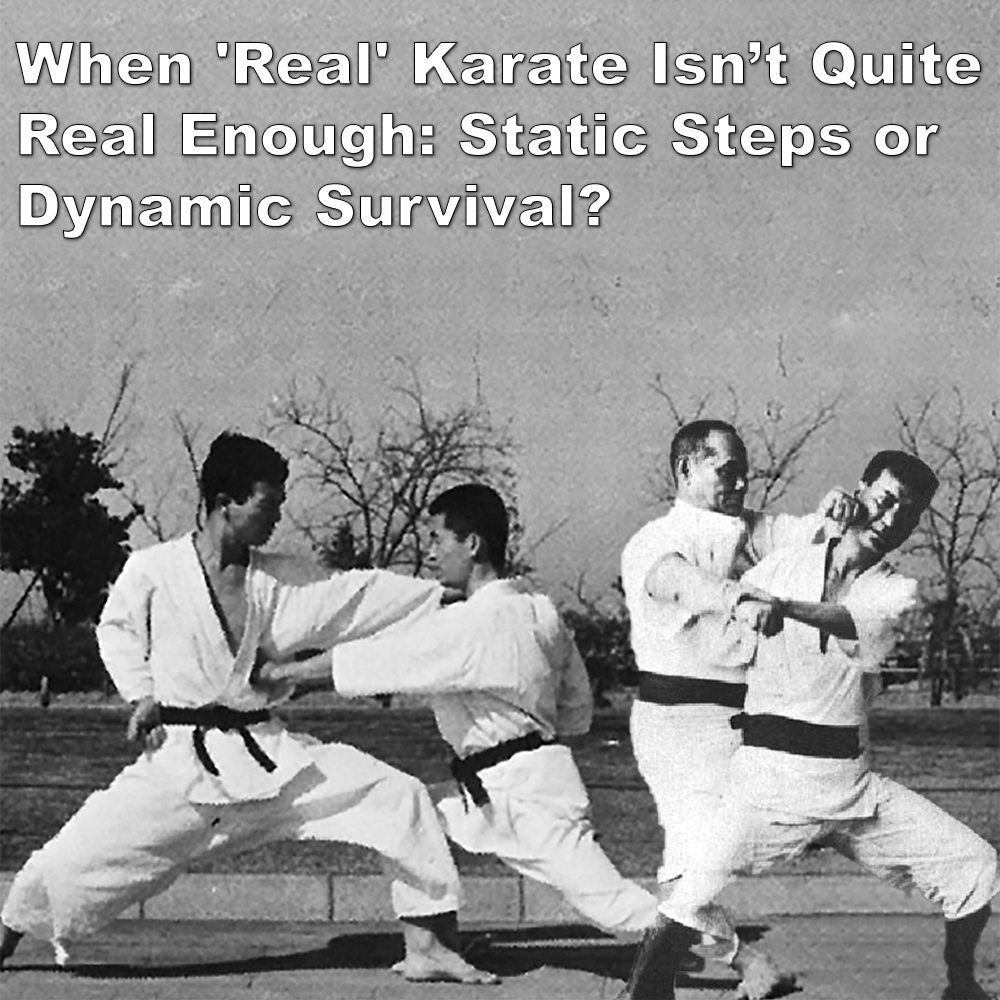
When ‘Real’ Karate Isn’t Quite Real Enough: Static Steps or Dynamic Survival?
Posted by ADAM CARTER on NOV 13, 2024

When ‘Real’ Karate Isn’t Quite Real Enough: Static Steps or Dynamic Survival?
(Approx 2 minute 40 second read)
I mentioned in an article recently that an Okinawan teacher showed his black belts a series of techniques meant to showcase ‘real’ karate. Unfortunately, expectations are never as exciting as reality.
Firstly, someone said to me in the comments section, “Can you provide a link to the video?” My reply is always the same: I generally avoid directing people to specific videos or naming individuals in my articles. My goal is to focus on the principles themselves rather than any particular source, to name and shame.
I’m not going to explain the video – it was far too long for that – but I will try to describe a scenario that arose when the instructor was teaching techniques to the class.
When you first learn any technique, it’s natural to stand still to perform them. Static training gives you and your partner time to understand the movement and allows you to coordinate your response. It’s part of the process of teaching a technique or introducing a technique to people who haven’t seen it before.
However, for those that expect realism straight away, this is only the first step. As you become more experienced practicing the technique, then speed, pressure, and aggression should be added to see if you can still perform it with the attacker acting more realistically, and importantly, aggressively resisting you.
Once you have the fundamentals down, an important part of this practice is that whenever an attacking technique is performed, for the defender, it’s imperative to consider not just the attacking limb but anything else that could be heading your way. Focusing solely on the one can get you into serious trouble, and often the opposite hand is perilously waiting there, dangling in mid air, or tight to the hip, not even considered.
The Okinawan karate concept of ‘meotode’ (literally, “husband and wife hands”) adequately describes how you can overcome this, as it teaches you to emphasize the use of both hands in defensive and offensive techniques. One hand often acts as a stabilizer, guard, or deflector, while the other delivers strikes, grapples, or manipulates the opponent.
One of the reasons I constantly write about context – and considering what was being shown on the video – is that karate step-kumite attacks, like the five-step practice, only develop bad habits if mistaken for practical training. These methods – essentially performances – only work in the controlled environment of a dojo or demonstration hall. Real-life attacks are chaotic, involving wild swinging limbs, aggression, and unpredictability.
So, why practice this way if it’s unlikely to reflect reality? What are you actually training for?
Many instructors justify it with the concept of “ma-ai” (timing and distance). While these are vital components of combat, my issue lies in how they are taught. These exercises often instill the wrong timing and distance, especially when the goal is to teach ‘real’ karate.
Of course, it’s essential to define what ‘real’ karate truly is.
However, karate’s movements were never designed to counter attacks from another martial artist. They were developed for practical self-defense against real-world threats: an enemy’s forward momentum, aggression, grabs, strikes, or even concealed weapons. These realities are absent in any step-kumite, and this is one reason why many interpretations of applications are woefully ineffective for self-defense.
Personally, I ditched step-kumite from my dojo long ago in favor of two-person drills based on the reality of HAPV (Habitual Acts of Physical Violence).
There are many alternative training approaches that could replace this ineffective method of training if your training for ‘reality’, which, in my opinion, offer a much more practical and effective way to develop your skills.
Because let’s face it, if the ‘real’ karate you’re teaching wouldn’t even scare a drunk uncle at a wedding, maybe it’s time to rethink the approach.
Written by Adam Carter – Shuri Dojo.
